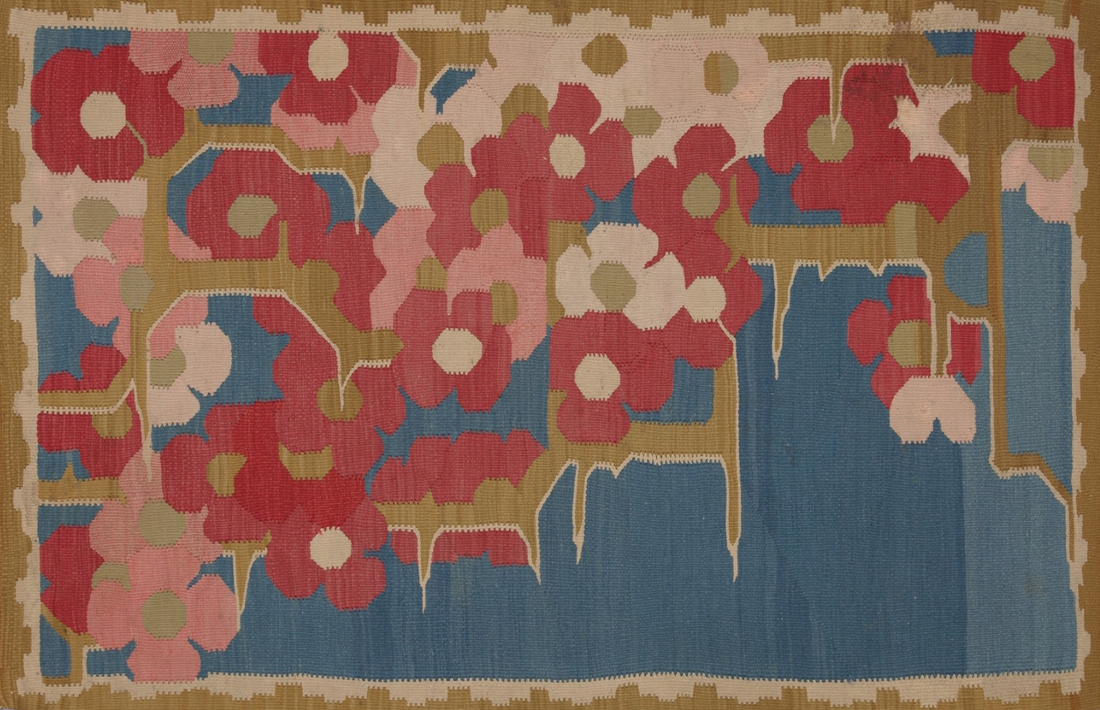
THE MYSTERY OF THE MISSING SWANS AND MAIDENS
A Frida Hansen Tapestry Tale
Text by Robbie LaFleur
I love tapestry mysteries - finding missing tapestries, or identifying tapestries with lost information. When I tried my best to figure out the location of Frida Hansen’s tapestry, Sørover [Southward], missing for ninety years, I failed! But when well-known rug dealer Peter Pap opened a plastic bin in 2021 and spied a folded tapestry with swans, he knew immediately he had struck tapestry gold. A quick google search turned up an article I wrote and he realised he was solving a mystery.
Frida Hansen (1855-1931) was an internationally-known Norwegian Art Nouveau artist at the turn of the 20th century. She created monumental tapestries that were purchased by museums across Europe, but her roots grew from traditional weaving in Norway. 
Image: Frida Hansen, Southward, 1903. © Peter Pap. Image above: Frida Hansen, The Norwegian Tapestry Weaving Mill (manufacturer), "Kveder (Quince)" / "Tjørn (Thorns)", 1903. © Nasjonalmuseet / Andreas Harvik.
During the 1890s Frida Hansen worked to rediscover old Norwegian weaving techniques and to build a thriving weaving business to support herself and others. She was deeply interested in the qualities of Norwegian wool, natural dyes, and historical Norwegian tapestry techniques. This was during the era of National Romanticism, when strong patriotic feelings led to the search for authentic, historical folk art. (For more on Frida Hansen’s life and career, read “Frida Hansen: A Brief Biography.")
Through the 1890s, Frida Hansen’s style changed and became more personal, with Art Nouveau, Arts and Crafts, and Japanese influences. In 1903 Frida Hansen wove red-haired maidens sailing on swans in a tapestry of impressive scale (11’3” x 10’3”). In her image from Norse mythology, the flotilla in Southward was sailing south, having brought the warmth and light of summer to the north. 
Image: The roses in the maidens’ dresses are woven in silver thread, which has oxidised to a dark coppery shade. © Robbie LaFleur.
The tapestry itself sailed from Norway as soon as it was cut from the loom, as it was purchased by Berthe Aske Bergh of Brooklyn, New York, a weaving instructor and passionate promoter of Norwegian billedvev (tapestry). She had been a student of Frida Hansen. During the next 27 years, Southward was admired by thousands of Americans in exhibitions at museums and other public venues. Though references to Southward praised its shining threads and beautiful colours, until today the only photographs documenting the tapestry were black-and-white, and blurry at best.
After 1931, there were no written references to Southward on display. Berthe Aske Bergh lived until 1954, and remained active in the Norwegian-American community. How could such a large tapestry disappear? Thankfully, the mystery has been solved!
As noted above, Peter Pap discovered Southward in 2021. The tapestry was last purchased from a New England family (name unknown) around 2010 by David McInnis, an antique dealer in New Hampshire who was Peter Pap’s friend. McInnis never displayed it, and he passed away before selling many of his treasures. Southward is part of his estate. 
Image: Mussels adorn each corner of Southward. © Robbie LaFleur.
We don’t know where the tapestry was for many decades, but it was clearly hung with care, or kept in environmentally safe storage. It was in excellent physical condition when it was unfolded from a bin in a storage room, but nearly 120 years of dust obscured the vibrant colours that Frida Hansen intended. Peter Pap sent the tapestry to Denver, Colorado, to be cleaned by the person he most trusted, Robert Mann. Careful washing brought out amazing brightness and contrast within the image.
Southward, in all its restored glory, was exhibited by Peter Pap at the Winter Show in New York City from April 1-10, 2022, the first public opportunity to see this magnificent tapestry since 1931, the last known year it was displayed publicly.
My initial research into the tapestry was sparked by curators who wanted to include the tapestry in the blockbuster show, Scandinavian Design in the U.S, 1890-1980. The tapestry was not discovered in time to include it in the excellent book, Scandinavian Design & the United States, 1890-1980, in conjunction with the show, but it was available for display at the Los Angeles County Museum of Art [LACMA], and currently at the Milwaukee Art Museum, through July 23. Textile lovers should visit the Scandinavian design show, to admire Southward and more than 15 other Scandinavian textiles.
Even better, if you want to see Frida Hansen’s work in person, visit the Stavanger Art Museum in Norway. Frida Hansen grew up in Stavanger and the museum has an outstanding collection of her work. 
Image: Decades of dust were removed with careful cleaning. © Robbie LaFleur.
Southward is still for sale; Peter Pap is in negotiations with museums in the U.S. and abroad. See this listing. If you would like to know more about the swans and maidens mystery, you can listen to this webinar produced by Vesterheim Norwegian-American Museum, “The Mystery of the Missing Swans and Maidens: A Frida Hansen Tapestry Tale,” or read these article from the Norwegian Textile Letter:
Close Encounters with Frida Hansen’s Swans and Maidens, 2022. (It includes many detail photos.); “Finding Frida Hansen’s Colors Again: Cleaning Southward;” “Southward on Display” (Read how contemporary accounts praised the tapestry when it was exhibited at least 15 times); and “Searching for Southward, A Missing Frida Hansen Tapestry” (This article is largely about Berthe Aske Bergh, the Brooklyn woman who purchased Southward).
But there are more mysteries to solve! Two other tapestries by Frida Hansen are missing in America. I’ve written about them on my blog (robbielafleur.com): “Another Missing Tapestry Mystery to Solve: Frida Hansen’s Mermaid from 1925,” followed up by “A Fugitive Frida Hansen Tapestry in Hawaii - Some More Clues;” and “Mermaids and Swans: Another Missing Frida Hansen Tapestry.”
My most recent challenge involves a tapestry owned by a Canadian man. His grandfather brought it from Tonsberg, Norway, in the 1950s. Who designed the tapestry of a troll woman and St. Olav? When I first posted the mystery, several people responded. Some wanted to provide more versions of the well-known story (including a punk rock song!), and one acquaintance sent a photo of another woven version.
I have solved other textile mysteries with the help of social media acquaintances - perhaps you have some clues for me? Write to me with your ideas!
